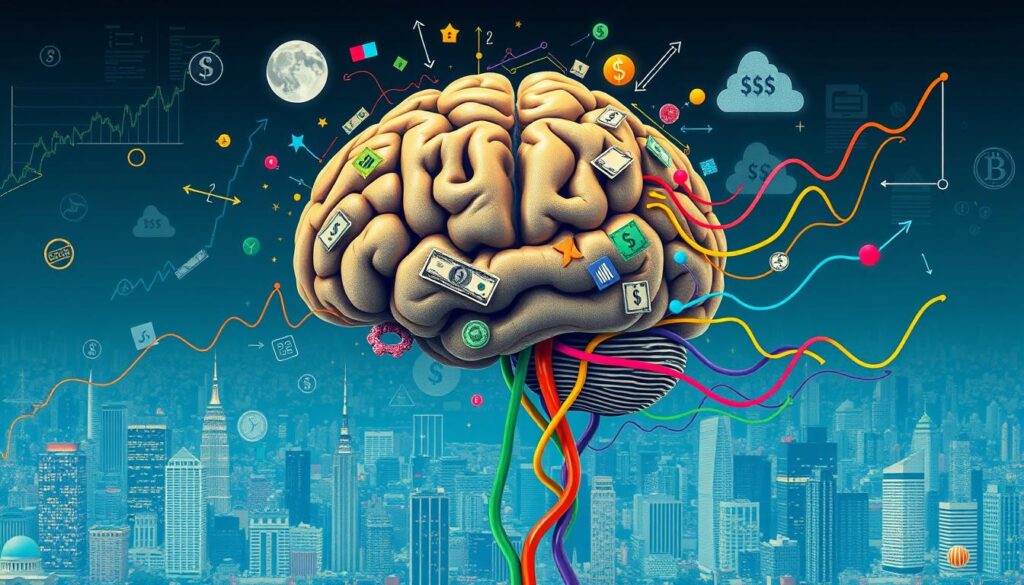
Behavioral Economics and Financial Decision-Making show us that we often think we make money decisions based on logic. But, our emotions and biases play a big part too. By learning about behavioral economics, we can beat these biases and choose better. This field mixes psychology and economics to study our financial choices.
Behavioral economics helps us understand what drives our money choices. This knowledge lets us make smarter financial decisions. In this article, we’ll dive into behavioral economics and how it helps us make better money choices. We’ll also share practical tips to apply it in your life.
Key Takeaways
- Understanding behavioral economics can help you make better money decisions
- Behavioral economics combines psychology and economics to understand financial decision-making
- By recognizing psychological biases, you can overcome them and make more informed choices
- Applying behavioral economics principles can improve your financial well-being
- Practical tips can help you use behavioral economics to make better money decisions
Understanding Behavioral Economics and Its Impact on Financial Choices
Behavioral economics studies how our financial choices and decision-making strategies are influenced by our minds and emotions. It helps us see how behavioral finance affects our money management. This knowledge lets us make better financial decisions.
Behavioral economics questions the idea that we always make smart, informed choices. In truth, our decisions are often swayed by biases and shortcuts in our thinking. These can lead to less-than-ideal financial choices.
What is Behavioral Economics?
Behavioral economics blends psychology, economics, and finance to understand our financial behaviors. It looks at the psychological aspects of money decisions. This way, researchers can find ways to improve our financial choices and develop better decision-making strategies.
The Psychology Behind Money Decisions
Studies reveal that emotions, social norms, and biases play big roles in our financial decisions. For instance, the fear of losing money can make us choose safer options, even if they’re not the best for us. Knowing these factors helps us craft better behavioral finance plans for our money.
Why Traditional Economic Theory Falls Short
Traditional economics believes we always make rational choices with all the information we need. But, this isn’t always true. Our decisions are often clouded by limited info, biases, and emotions. By acknowledging these limitations, we can gain a deeper understanding of financial choices and decision-making strategies.
Common Cognitive Biases Affecting Your Money Management
Cognitive biases can greatly affect our financial choices, leading to poor money management. These biases are systematic errors in thinking that lead to irrational choices. It’s important to understand these biases to make better financial decisions.
Some common cognitive biases include confirmation bias, anchoring bias, and loss aversion. Confirmation bias is when we look for information that supports our beliefs. Anchoring bias is when we rely too much on the first information we get. Loss aversion is when we fear losing more than we value gaining.
- Confirmation bias: seeking out information that confirms our existing beliefs
- Anchoring bias: relying too heavily on the first piece of information we receive
- Loss aversion: fearing losses more than we value gains
Knowing about these cognitive biases helps us make better choices and improve our money management. By recognizing these biases, we can lessen their impact and make more rational financial decisions. Effective decision analysis is key to overcoming these biases and reaching our financial goals.
The Power of Loss Aversion in Financial Decision-Making
Loss aversion is a bias that affects how we make financial choices. It makes us fear losses more than we value gains. This can make us avoid risks and miss out on good investment chances.
This bias plays a big role in our decision-making. It can lead to irrational choices. For example, an investor might keep a losing stock because they fear losing money. They might miss out on better opportunities.
Understanding Loss Aversion
Loss aversion is shown in a simple example. Would you rather get $100 or avoid losing $100? Most people choose the second option. This shows how loss aversion affects our money decisions.
How Loss Aversion Impacts Investment Choices
Loss aversion can cause problems, including:
- Over-diversification: spreading investments too thinly to avoid losses
- Risk aversion: not taking on investments that could be profitable because of fear
- Analysis paralysis: being too cautious and indecisive because of fear of losses
Overcoming Loss Aversion Bias
To beat loss aversion, we need a balanced way of making financial decisions. This can be done by:
- Setting clear investment goals and knowing our risk level
- Diversifying investments to reduce risk
- Regularly checking and updating our investment portfolios
How to Use Behavioral Economics to Make Better Money Decisions

Learning about behavioral economics can change how we handle money. It helps us make smarter choices. By fighting our own biases, we can improve how we manage money. This means knowing what drives our financial decisions and using strategies like diversifying and averaging costs to get better returns.
Using tools like budgets and financial plans is key. These tools help us make choices that are not based on quick decisions. For example, a budget helps us focus our spending. It ensures we’re using our money wisely and in line with our goals.
It’s also important to be aware of how our behavior with money affects us. We need to understand how feelings and social pressures can lead to spending too much. By being mindful, we can develop healthier money habits. This leads to better financial decisions and a more stable future.
Applying behavioral economics can make a big difference. Here are some tips to get you started:
- Automate savings to fight off impulsive spending
- Use the 50/30/20 rule to manage your income
- Don’t let your spending grow with your income; focus on needs over wants
The Role of Mental Accounting in Personal Finance
Mental accounting is a part of financial psychology. It’s how we treat different money types based on where it comes from or what we plan to use it for. This can lead to spending too much in some areas or saving too little in others. It plays a big role in how we make financial choices.
It’s key to understand mental accounting to make smarter money decisions. Our brains sort and value money differently, like treating gift money and salary money differently. This can cause us to make choices that aren’t always good for our finances.
Understanding Mental Accounting
To avoid falling into mental accounting traps, we need to organize our finances well. We can do this by setting clear financial goals and focusing on what we really need over what we just want. This helps us manage our money better and work towards financial stability in the long run.
Breaking Free from Mental Accounting Traps
Here are some ways to beat mental accounting traps:
- Make a single financial plan that treats all money the same
- Set achievable financial goals and keep track of how you’re doing
- Be mindful of your spending and avoid buying things on impulse
By recognizing the impact of mental accounting on our finances and working to overcome it, we can develop better money habits. This improves our financial health and overall financial mindset.
To explore the foundational concepts and key figures in behavioral economics, visit this insightful resource from the Nobel Prize website: Behavioral Economics – Nobel Prize.
Anchoring Bias and Price Perception
When we buy things, we often start with the first price we see. This can lead to anchoring bias. It makes us pay too much for things. To avoid this, we need to think carefully about our choices, looking at all the facts.
One way to beat anchoring bias is to look up prices before buying. This helps us see things more clearly and make better choices. Knowing about anchoring bias also stops us from buying things on a whim.
By understanding how anchoring bias affects our views on prices, we can make smarter choices. This leads to better financial health through careful decision analysis.
| Strategy | Benefits |
|---|---|
| Research and compare prices | Accurate price perception, informed decision analysis |
| Avoid impulsive purchases | Reduced risk of overpaying, improved financial decision-making |
Social Proof and Financial Decision-Making
We often look to others for financial guidance. This is called social proof, where we follow what others do. It can greatly affect how we handle money, leading us to make choices based on what others do, not our own goals.
Social proof can be good or bad for our money habits. Seeing smart financial moves from others can inspire us to do the same. But, following the crowd can also lead to bad money choices, like spending too much or taking big risks. It’s key to understand how social proof affects our money decisions and make choices that fit our financial goals.
To benefit from social proof, surround yourself with people who manage money well. Learn from their experiences. Also, find financial advisors or mentors for guidance. By being aware of the social proof around us and making smart choices, we can improve our money habits.
Present Bias and Long-Term Financial Planning

Present bias can really hinder our financial choices. It makes us focus on quick wins rather than long-term gains. This can lead to spending too much now and forgetting about our future plans. It’s crucial to grasp how present bias affects our long-term financial planning.
To beat present bias, we need to see how it shapes our decision-making process. Knowing its power, we can start to change. We can set financial goals, make a budget, and plan for the long haul.
Here are some ways to fight present bias:
- Break down big goals into smaller, easier steps
- Make a savings plan with automatic transfers
- Get advice from a financial advisor to stay on track
By tackling present bias, we can make better financial choices. This helps us reach our long-term financial planning goals. And that leads to a more stable and secure financial future.
Implementing Behavioral Economics in Daily Financial Choices
By using behavioral economics, people can improve their money habits and make smarter financial choices. It helps us understand how our minds influence our money decisions. Behavioral economics sheds light on the biases and shortcuts that shape our financial choices.
To better manage money, we need to know our financial psychology and create systems for making decisions. This includes budgeting, planning, and using tools to track our spending. Key strategies for using behavioral economics in our daily money decisions include:
- Setting clear financial goals and priorities
- Using mental accounting to categorize and manage finances
- Avoiding loss aversion and other cognitive biases
- Leveraging social proof and peer influence to support financial decisions
By applying these strategies, we can make better financial decisions and reach our goals.
Creating Better Money Habits
Improving our money habits is key to using behavioral economics in our daily choices. It’s about setting up systems that help us make smart financial decisions. By understanding behavioral economics and financial psychology, we can build habits that help us reach our financial goals.
Building Financial Decision-Making Systems
Creating systems for making financial decisions is crucial for smart daily choices. This means setting a budget, setting goals, and using tools to track spending. By using behavioral economics and financial psychology, we can build systems that support our financial health.
Conclusion: Transforming Your Financial Future Through Behavioral Economics
As we wrap up our look at behavioral economics and money, it’s clear. Understanding and using these ideas can change our financial future. By knowing our biases and finding ways to beat them, we can make smarter money decisions.
This article has given us tools to improve our money habits. We can make better choices and use technology to reach our goals. With this knowledge, we can manage our money better and look forward to a brighter future.
The secret to success is knowing ourselves, questioning our beliefs, and always trying to get better at making money choices. By using behavioral economics, we can reach our financial dreams.
Freelancers gain a lot from using credit cards made for them. They get rewards, cashback, and tools to track expenses. The top cards for freelancers tackle the unique money challenges they face. This makes managing money and growing your business easier. for more about on this topic then check this – Credit Cards for Freelancers: Find the Right One for You
Behavioral Economics and Financial Decision-Making : FAQ
What is behavioral economics?
Behavioral economics mixes psychology and economics to study how we make money choices. It shows that we’re not always logical. Our decisions are swayed by biases and shortcuts in thinking.
How does traditional economic theory fall short in explaining human behavior?
Old economic theories think we make smart choices with all the facts. But, behavioral economics says we’re influenced by our minds. This can lead to choices that don’t make sense.
What are some common cognitive biases that affect money management?
Money choices can be clouded by biases like confirmation bias and anchoring bias. Confirmation bias makes us look for info that backs our views. Anchoring bias makes us stick to the first info we get. Loss aversion makes us fear losing more than we value winning.
How does loss aversion impact investment choices?
Loss aversion makes us play it safe with money. We might hold onto bad investments too long or avoid risks. This can stop us from reaching our financial goals.
How can we use behavioral economics to make better money decisions?
Knowing behavioral economics helps us make smarter money choices. We can fight our biases and use strategies like diversifying and dollar-cost averaging. Tools like budgets and financial plans also help us make better decisions.
How does mental accounting affect personal finance?
Mental accounting treats different money types differently. This can lead to spending too much in some areas or saving too little in others. Breaking these patterns and organizing our finances better can improve our money decisions.
How does anchoring bias affect price perception?
Anchoring bias makes us rely too much on the first info we get. This can make us pay too much for things. Fighting this bias and making informed choices is key.
How does social proof influence financial decision-making?
Social proof makes us follow others, especially when we’re unsure. This can lead to spending too much or making bad investment choices. It’s important to use social proof wisely and make informed decisions.
How can present bias affect long-term financial planning?
Present bias favors short-term gains over long-term goals. This can lead to overspending now and neglecting future plans. Fighting this bias and focusing on long-term goals is crucial.
How can we implement behavioral economics in our daily financial choices?
By applying behavioral economics, we can improve our money habits. This includes setting up systems like budgets and financial plans. Using tools and tech to track spending also helps us stay on track.







